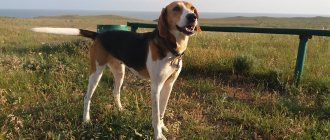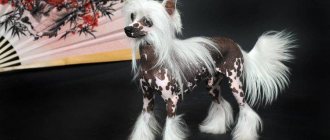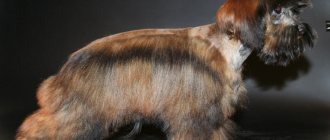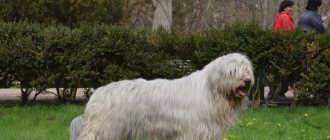Description and features
The homeland of this beautiful animal is Russia, or rather the Soviet Union. It was bred in the 50s of the 20th century. The Russian lapdog in the photo looks decorative, however, almost all breeds selected here have exclusively working purposes.
Initially, the dog was used to guard and transport cargo on carts. It’s amazing, but the gentle lapdog can even hunt, and does it with joy. She is devoid of bloodthirsty instincts, but the desire to catch prey appears if she needs to get the owner's approval.
For his sake, the dog is ready to do anything, even give his life. Boundless devotion to one person is its basic feature. The Russian lapdog becomes so attached to its owner that it can even die from melancholy if it faces a long separation from him.
Interest in breeding cute ornamental dogs appeared only after the end of World War II. At that time, on the territory of Russia, different miniature breeds of dogs were actively crossed in order to obtain a small, attractive-looking and, at the same time, efficient individual.
In those years, the demand for such animals was enormous. Women showed particular sympathy for them. The beauties of that time were pleased to go out into the world holding a fluffy and cute dog in their arms, radiating tenderness. They were noticed, loved and pampered.
The Russian lapdog is a good companion and friend. It is pleasant to interact with her, she helps to get rid of sadness and other negative emotions. In addition, the animal is very smart. It always understands if its owner is unhappy. But the owner’s joy will certainly make the dog happy and make him more cheerful.
The Russian lapdog becomes very attached to its owner and misses him greatly.
It’s hard to believe, but despite its miniature size, this breed is very hardy and strong. Its representatives can not only relax on upholstered furniture, but also quickly catch up with forest animals, take part in races and other competitions.
Such a pet will certainly brighten everyone's life. He is friendly, cheerful, gentle and loving, at the same time courageous, purposeful and fearless. Family safety is the animal's priority. It will not tolerate the presence of an intruder in the house and will definitely fight back.
History of the origin of the species
The history of the breed is short and not rich in historical facts. The fact is that decorative breeds were not popular in Russia until the Second World War. All dogs were useful on the farm and carried out working functions.
Since the 45-50s, when fashionistas began to be interested in Western culture, the first ladies of the USSR received rare copies of Lapdogs from abroad. The quality of further breed lines in Russia was terrible. Then it was decided to breed a new dog. The clubs were created on the basis of nurseries for hunting and service dogs.
In 1951, the first black puppy named Tim-tim was received. His parents were white and coffee lapdogs. In addition to them, Shih Tzu and Lhaso Apso took part in further selection. Puppies that matched their phenotype and color were selected.
By the end of the 50s, the line was formed. In 1999, the first breed club in Russia was created and a standard was published. Unfortunately, the Tsvetnaya lapdog has not yet received international recognition.
Breed standard
This dog is compact, beautiful and very fluffy. Its body is oblong and square. The body posture is high and muscular. The chest moves forward slightly at the moment of movement. There is a slight bulge in the lower back.
The Russian lapdog has a small head and a pronounced muzzle. The nose is small and pigmented. According to the standard, if a dog is born with a light shade of fur, its nose has a similar color.
The dog's bite is correct. Her jaws are tightly closed. The teeth are tiny. The eyes are large and round. Most often, the color of the iris is brown. Eyes that are too protruding are considered a deviation. Also, they should not be planted deep.
The lapdog's ears are set high, have a clear triangular shape, and are narrowed upward. This is her “calling card”. The dog's ears are covered with long hair, which needs to be combed every day.
The animal's thighs are muscular and strong. This allows you to quickly push off from the ground. The limbs are stable and strong. The front ones are shorter than the rear ones. The pads of the feet are dark colored. The tail is rounded, located high on the lower back. Covered with fur along its entire length.
The main visual feature of the Russian lapdog breed is its thick fur. It is so beautiful that it even sparkles in the sun. According to the standard, it should be slightly wavy. Individuals with curly hair are not allowed to take part in competitions and exhibitions.
In addition, the dog has a dense undercoat. Almost any solid color is acceptable, except beige and white. Touching the thick fur of a lapdog is very pleasant. It feels like silk to the touch.
Rarely is a dog of this breed born purely black or brown. Usually, the price of such individuals is much higher. Regardless of the color of the fur, the dog may have light markings on its chest and ears.
Russian Tsvetnaya lapdog description of the breed character. Breed characteristics and character
The name of the breed speaks for itself.
The Russian lapdog appeared in St. Petersburg in the post-war years - in the 50s of the last century. The dog's ancestors include a French lapdog, toy poodles, and a Shih Tzu. The dogs received recognition 10 years later, and only in Russia. The lapdogs have not yet received international recognition. However, besides Russia, they are popular in Scandinavia and the Benelux countries - Germany and the Czech Republic.
The animal is popular; breeders are engaged in its breeding. There are clubs dedicated to lapdogs and many kennels. The popularity of a dog is influenced by its unpretentious character, sociable qualities and high adaptive abilities.
As a rule, a negative trait of many small dogs is increased aggressiveness. The Russian lapdog breed is a pleasant exception. The pet is affectionate and infinitely devoted to its owner, ready to be a companion even on long walks, gets along well with children, although teenagers, not toddlers, as well as with other animals in the house.
Can be aggressive towards young children. The downside of the breed is that the dog is very loyal. Worried if the owner left home for work. Almost cannot stand longer absences.
Dog handlers strongly do not recommend getting a dog for people who travel frequently. The dog may simply not tolerate separation. In everyday life, the lapdog is moderately playful and cheerful, smart, but at the same time careful.
She won’t be the first to attack, but she will always respond to rudeness. Very sensitive to the mood of loved ones. Despite its small stature, it has good protective qualities. If there are guests in the house, he will treat them with restraint. The main thing is that the owner is nearby. If the dog sees that strangers have entered the home, but the owner is not there, he will not let the uninvited guests go.
Character
The Russian lapdog simply cannot help but become everyone's favorite pet. She is so charming that she will melt the ice in the heart of even the most brutal person. She experiences tenderness for every living creature throughout her life. First of all, we recommend that large families get such a dog.
If children live in the house with the dog, you should know that every second, every family member will feel happy vibes. The interaction of a representative of this wonderful breed with small children can be called touching.
He is affectionate and sensitive with them. Under no circumstances will a lap dog harm a person, especially a small one. However, she is capable of feeling resentment. This is a vulnerable animal that needs the reverent attitude of all family members.
The Russian lapdog has a playful character
Rough treatment is unacceptable. Some dogs that have been hurt by people since childhood become overly suspicious and angry, but the lapdog does not. It is hard to bear resentment, but having experienced it once, he will not harbor a grudge. Melancholy and sadness are the emotions that an offended dog of this breed is prone to display.
The house where a Russian lap dog lives will never be calm and quiet. The dog is very playful and cheerful, she is always interested in spending time together with members of the household. She is attracted to chasing stuffed animals and some cat pranks.
For example, the animal will probably enjoy lying on the floor together, loud laughter and belly rubs. It cannot live a day without tactile contact. This is a very gentle and affectionate breed.
Yes, her appearance can be called “toy-like”. But this does not prevent her from being a strong dog capable of protecting her beloved family. Do not forget that she has the genes of guard dog breeds. Of course, the Russian lapdog is too small to neutralize an armed robber, but if she feels threatened, she will attack without hesitation!
The animal barks loudly only if it senses other dogs nearby. It is a mistake to think that this is how he expresses aggression. For dogs, barking is a means of communication. They communicate by making loud noises.
Such a pet can hardly be called uncontrollable and unbalanced. Usually, he grows up obedient. The dog's calm disposition is its main advantage. They often take lap dogs with them on visits, to social evenings, to shops, restaurants, and even to nature. Being in the arms of a familiar person, dogs will not panic and break free. They always rely on their owners, trusting them completely.
Energy and mobility are qualities that complement the list of distinctive features of representatives of this breed. You can take them with you for a run and even for swimming. Spending time with family members makes these animals happier.
It is believed that the Russian lap dog has a sixth sense and well-developed intuition. It accurately determines the current emotional state of a person, adapting to it if necessary. That is, if, in the dog’s opinion, its owner is upset about something, she will not carry him the ball and invite him to play, but will simply come closer and share his sadness with him.
Types of lapdogs
Maltese
This species is the most popular not only among lapdogs, but also among all decorative dogs in general. The Maltese (or Maltese) dog is characterized by a long coat of white or ivory color. During the time of the Chinese emperors, they were considered "royal" dogs. The breed itself is unpretentious. Due to the length of the coat, it requires constant care, which can be easily done at home. With proper care, it practically does not shed. The dog has an obedient and good-natured disposition.
French
The peculiarity of this breed is its curly white coat, which grows throughout the animal’s life. Therefore, it requires special careful care. Individuals participating in exhibitions need systematic visits to grooming salons and professional care throughout their lives. Another distinctive feature is the black expressive eyes, revealing the curiosity of the owner.
The historical roots of this type of lapdog go deep into the past. Despite the passage of centuries, the modern appearance is little different from its ancestors.
Havanese (Havanese)
The breed is relatively young, bred in Cuba. It is quickly gaining popularity around the world. The Havanese is a glamorous breed, sought after by wealthy people. Due to the need to live in comfortable conditions, inherent at the genetic level, it is not suitable for the average person or for people who do not have the opportunity to devote sufficient time to proper care and high-quality nutrition.
The appearance of a pet, just looking at it, evokes an irresistible desire to stroke its soft fur, pick it up and enjoy the sight of its charming face.
The Havanese dwarf dog is very good-natured, easily gets along with people and other inhabitants living in the house and meeting on the street while walking. They are absolutely alien to aggression and irritability. They need protection from the unfriendliness of other animals and people.
Russian Tsvetnaya lap dog
A distinctive feature of this species is its unusual coat color. Unlike the white color of other species, it has all shades of beige, gray and brown. The smallest white spot is classified as a defect. The breed was bred in Leningrad and for a long time was not officially recognized due to the admixture of poodles and Shih Tzu. It was recognized only in the 60s of the last century. Another unusual trait for lap dogs is the guard instinct. The dwarf dog rushes at anyone if it feels a threat to its owner. In everyday life she is quite friendly, flexible and compliant.
The disadvantage of the breed is that it does not get along well with very young children and is intolerant of loneliness. The dog should not be left alone for a long time; it may become depressed, melancholy or angry. Constant company needed.
Italian (bolognese)
Purebred representatives of this breed have a snow-white color that does not allow any spots. These are true aristocrats with a wayward temperament. Outwardly proud, they constantly require attention and increased care. Back in the twelfth century, these mini-dogs were in great demand in the homes of Italian aristocrats and were decorations for rich ladies and were presented as gifts.
We advise you to read: Welsh Terrier Dog Breed
Externally, Italian lapdogs, due to their fluffy fur that hides their graceful body, resemble a round soft lump.
Bologneses are very susceptible to injury due to their small size. For this reason, it is not recommended for families with small children. The breed has good health and, with proper care and maintenance conditions, has a long life expectancy, from 14 to 18 years.
Kinds
There are several types of lap dogs. They are united by several parameters: miniature, friendliness and lush fur. Mostly women like to have such dogs. Let's consider the popular types of lapdogs, except Russian:
- Bichon Frize. The second name of the dog is “little lion”. These are small and very fluffy dogs that resemble stuffed animals. The Bichon Frize is a good decorative breed, perfect for apartment living.
- Havanskaya. This dog was bred by crossing other types from this group. He is small, has a pleasant appearance, very sweet and affectionate.
- Bolognese. The dog's homeland is France. She is considered the most sociable lap dog.
- Coton de Tulear. A very mischievous and nimble dog. He is filled with energy. The homeland of Coton de Tulear is the famous island of Madagascar.
- Maltese. One of the oldest representatives of this group of dogs. The Maltese is very fluffy.
- Levchen. The dog is very similar to a large Persian cat. He is just as graceful and fluffy. They cut it so that it resembles a decorative lion with a lush mane.
Care and maintenance
Living in a confined space will make absolutely any dog unhappy. A purebred dog should periodically leave its territory. This is necessary to gain new emotions and impressions.
The Russian lapdog is a classic “indoor” version of a pet. She does not require frequent walks, like, for example, a Chihuahua, and tolerates separation from household members, but not for long.
When leaving the apartment and leaving the dog alone, do not worry about the safety of household items. The lapdog will not spoil your shoes or tear up furniture with pillows. Usually, when left alone in the apartment, she lies down at the front door, waiting for the people dear to her to return. Rest assured, the arrival of a stranger in the house will definitely not be a reason for her to be warmly received.
Of course, if one of the family members is in the apartment at that moment, the animal will not attack the person who comes. This is how a dog’s intellectual potential is revealed. A smart dog always relies on the owner, that is, the arrival of a stranger for him is an event that a person must control.
To make the life of a Russian lap dog comfortable, you should purchase a lot of colorful soft toys for it. Brightly colored rubber animals, such as ducklings, work best. They are easy to find at any pet store.
Now about leaving. The Russian lap dog is unpretentious in this regard. But, she has a long, silky coat that should be brushed daily. We recommend using a metal comb. Some owners cut their dogs' hair in the summer to keep them cool. It makes sense. In this case, there is no need for daily combing.
Important ! If your Russian lap dog takes part in any competition or is shown at an exhibition, its coat requires additional care. We recommend using conditioner for decorative dogs along with shampoo.
Girls' lap dogs often have their hair braided, and I attach various hairpins to the hair. This way they look more attractive, but in this case you will have to comb their fur more often. Additional care points:
- Washing. Remove stains from your dog's eyes with a damp hand.
- Removing dental plaque. Since lap dogs have very small teeth, cleaning them is not easy. But, this must be done at least once a month.
- Grinding claws. Representatives of decorative dog breeds need to file or trim their claws, as they cannot cope with this task on their own.
- Removing sulfur. Every day, dust and dirt accumulate in the ears of animals, which should be removed in a timely manner. Otherwise, severe inflammation occurs.
How to choose a puppy
The Russian colored lapdog is not recognized by the international cynological organization, so purchasing a puppy is not an easy task. There are not many official nurseries in Russia that breed the breed. Buying a puppy from a private person does not always guarantee the health of the pet, but it may be cheaper.
- The breeder must provide all the necessary documents and tell the future owners everything about the breed line and the dog’s parents. He has the right to refuse a sale if he believes that people will not be able to care for the animal.
- Before purchasing, owners must decide on the gender and class of the dog . Bitches are more flexible and can bear offspring, males are more active and playful. If the pet is purchased as a pet, then a pet-class puppy is suitable, but if for exhibitions, then a show-class puppy.
- Healthy dogs will be active and inquisitive. The one who pays attention to the people who come first, as a rule, becomes the most devoted friend. The cost of lap dogs depends on their class and varies from 5,000 to 30,000 rubles.
A dog, even one as small as a Russian Tsvetnaya lapdog, is a big responsibility. The decision to purchase should be made by the whole family. This dog will be able to give all his love and devotion, but will require a lot of attention in return.
Nutrition
The duration and quality of your pet’s service depends on quality nutrition. In order for him to always remain healthy and beautiful, his body must regularly receive beneficial nutrients, from carbohydrates to plant extracts.
A Russian lapdog puppy should eat at least 100-150 grams of lean meat, such as chicken, every day. By the age of six months, its skeleton is formed and weight gain occurs. At this stage, it is important to lay the foundation of his health and immunity. Meat portions should alternate with dairy portions. Every lapdog needs such natural nutrition. In addition to the above, its menu may include:
- Borscht, soup.
- Lean fish.
- Cottage cheese, butter, sour cream.
- Chicken eggs.
- Broccoli, greens.
- Apples, bananas, strawberries.
- Non-acidic berries.
You should not experiment with your pet's menu. If the “wrong” food gets into his stomach, he risks getting sick. List of foods prohibited for lap dogs:
- Semi-finished meat products (for example, dumplings and pasties).
- Mayonnaise.
- Raw potatoes.
- Fatty meat (for example, pork).
- Peppery or salty dishes.
- Pasta.
- Sweets, including cream cakes.
It is better to feed a small lap dog frequently, at least 4 times a day. The number of meals is reduced gradually. An adult dog of this breed's bowl is filled with food twice a day. By the way, you can give your one-year-old pet dry food. But choose only a quality product!
Reproduction and lifespan
On average, this adorable dog lives for 14 years. With good care, its service life is extended to 1-2 years. Healthy, sexually mature and strong-looking Russian lap dogs are allowed to reproduce. The recommended age for breeding them is 2-3 years.
Before breeding animals, the breeder must make sure that they are not related. Otherwise, he will not get healthy puppies. So, mating occurs in the middle of the bitch’s estrus period, on days 3-5. The countdown should be carried out after the appearance of blood discharge.
Russian lapdogs are peace-loving dogs, so they rarely show hostility towards each other when meeting each other. But if the bitch doesn’t like something, she can push the male away. In this case, there is no need to force them on each other. It is better to postpone the mating for a couple of days.
Price
Having such a “living toy” at home is a great happiness. But, unfortunately, in Russia you can’t buy it in every city. Therefore, if you want to become the owner of a purebred Russian lap dog, you will have to go to the capital, that is, to Moscow, to get it.
It is in this city that there are 2 kennels where such dogs are professionally bred. There, the buyer will be provided with information about the health status of each puppy and will be helped to choose one. The price of a Russian lap dog from a nursery is 20-25 thousand rubles.
If you want to save money, you can use another method of purchasing - from your own hands. The cost of a puppy of this breed from breeders for 2021 is 8-15 thousand rubles. Individuals painted black or brown are considered rare, so they can be more expensive.
History of the breed
The Russian Tsvetnaya lapdog is a new breed, it is not yet 70 years old. It appeared thanks to enthusiastic dog handlers in the middle of the last century in Leningrad. Life, in the post-war period, improved and interest in small breeds of dogs gradually increased. In 1951, the first representative of this breed was obtained.
Later, in an attempt to make the Russian lapdog breed more miniature and pretty, it was crossed with the French lapdog, Shih Tzu, Pekingese and Lhasa Apso.
Russian beauty
Information: Most likely, the pedigree of the Russian lap dog included dwarf poodles, and according to some sources, even mongrels, who were selected for their height and pretty faces, were included in their genus.
In 1966, the standard for this dog breed was approved by the Kennel Council, and in the 70s of the last century, colored lapdogs became increasingly popular, and the first kennels appeared in Moscow.
However, in the turbulent 90s, Russian lap dogs went through hard times, and only at the end of the century a club for lovers of this breed finally appeared in St. Petersburg.
Now, strange as it may seem, the Russian colored lapdog breed is more popular in Europe than in Russia. For many Russians, lapdogs are still associated with white shaggy dogs, which bear little resemblance to our domestic breed.
Education and socialization
The Russian lapdog is a sociable and peace-loving dog. She is upset by people's quarrels among themselves, their screams and hysterics. Therefore, it is important that a friendly atmosphere reigns in the apartment in which such a pet lives.
It is useless to teach a decorative dog strict guarding, ferocious hunting and observation. He will not be able to go against his nature. But teaching him circus tricks is quite easy.
Lapdogs are smart dogs, so even a child can handle their training. When you bring a small and cute dog into your home, show him a place where he can sit. When he approaches him, say clearly: “Place!” Repeat this command daily, and then your pet will remember it and will be able to leave the room at any time if circumstances so require.
If your pet tries to bite someone, even during play, do not let him do it. Say loudly: “Ugh!” Every pet dog must know this command, especially those who live in an apartment. Also, don't let her chew on pillows or furniture.
If you didn’t take care of your pet and he still chewed something, you should scold him for it, but don’t even think about using physical force! The Russian lapdog requires a tender and reverent attitude. She shouldn't feel pain. The best punishment for her is verbal.
You can train your dog to fetch a ball. Every time you throw it in front of you, say: “Fetch!” The game should be called “Where is the ball?” Every time you say these words, the mischievous dog will go in search of his favorite toy and bring it to you.
It should be noted that representatives of this breed do not need serious educational work. They are smart, obedient, and not prone to dominance. Such pets are a model of obedience and devotion. But, due to their strong attachment to their family members, they periodically act out when they are left alone at home.
By causing damage to household items, the dog tries to attract the owner’s attention and force him to stay at home next time. If your Russian lapdog is prone to this behavior, we recommend equipping him with a spacious playpen. Leave it there every time you plan to leave the apartment for a while.
Character of the breed
The colored lapdog is a faithful and devoted dog that will follow its owner anywhere. This breed is active and loves to run and play. Therefore, if you lead a passive lifestyle and like to lie on the couch, then such a dog will not suit you. Colored lap dogs are very active, love long walks, and will happily run with a ball. At the same time, if you are busy with something, the dog will not disturb you, but will simply lie down next to you and not disturb you in any way.
Russian colored lapdogs are quite smart dogs. With proper and regular training, they will surprise you with their abilities. Colored lapdogs are friendly dogs that get along easily with other pets. Therefore, if you have a hamster or a cat, then the colored lapdog will only be happy to have such company. In general, this breed does not tolerate long periods of loneliness. Therefore, if you are often away from home for a long time, consider whether to buy this dog. At the same time, if you are away from home for a long time, the dog will not be so lonely.
Colored lap dogs do not tolerate rudeness or bad treatment. They perceive it as hostile. Therefore, if you have small children in your home, you should carefully monitor their interactions with the dog. A colored lapdog may perceive a child's actions as a threat and may bite.
Possible diseases and methods of treating them
There are no specific genetic diseases in Russian lap dogs. They are strong, resilient and healthy. To make sure your pet doesn’t get sick, we recommend that you vaccinate him regularly. First, the dog should be registered with an animal clinic.
There he will get a passport, where information about him and its owner will be entered. Secondly, don’t forget about vitamins! Zoological salons and stores sell special immunostimulating complexes for animals.
Advice ! You should not prescribe vitamins to your lapdog on your own. This should be done by the veterinarian examining her. For prevention purposes, we recommend regularly giving your dog medications against parasites: worms, ticks and fleas.
The doctor must write recommendations on their prescription in the dog’s personal passport. Don't forget to take him for a medical examination at least once a year! This will help avoid the development of pathology in his body. The first sign of a sick dog is refusal to eat. In addition, an unhealthy dog exhibits the following symptoms:
- Lethargy, weakness.
- Dry nose.
- Whining.
- The desire to be alone.
If you suspect that your lapdog is sick, we recommend taking her to the doctor.











